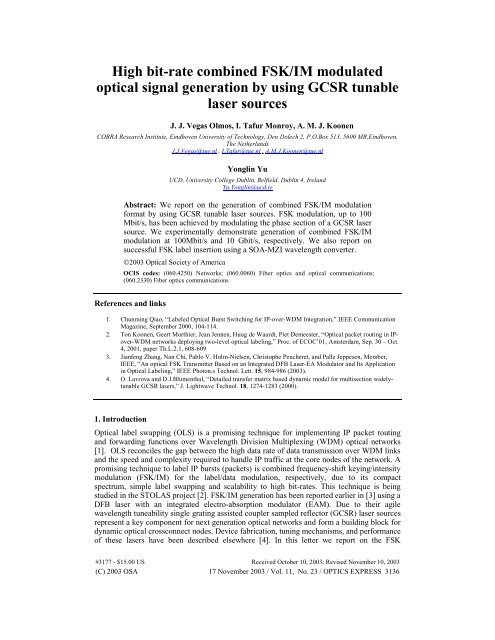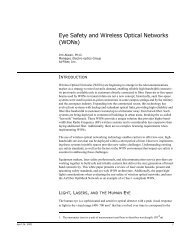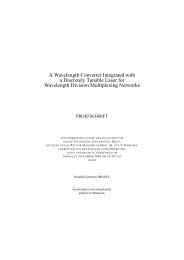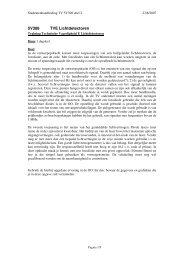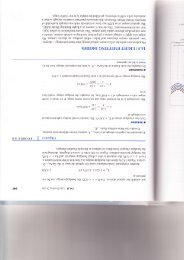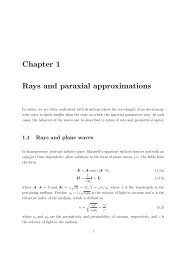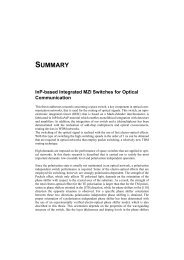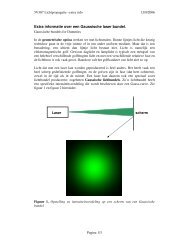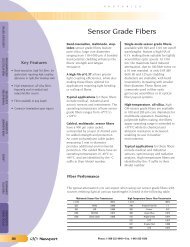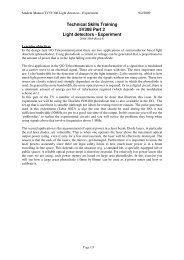High bit-rate combined FSK/IM modulated optical signal generation ...
High bit-rate combined FSK/IM modulated optical signal generation ...
High bit-rate combined FSK/IM modulated optical signal generation ...
You also want an ePaper? Increase the reach of your titles
YUMPU automatically turns print PDFs into web optimized ePapers that Google loves.
<strong>High</strong> <strong>bit</strong>-<strong>rate</strong> <strong>combined</strong> <strong>FSK</strong>/<strong>IM</strong> <strong>modulated</strong><br />
<strong>optical</strong> <strong>signal</strong> <strong>generation</strong> by using GCSR tunable<br />
laser sources<br />
J. J. Vegas Olmos, I. Tafur Monroy, A. M. J. Koonen<br />
COBRA Research Institute, Eindhoven University of Technology, Den Dolech 2, P.O.Box 513, 5600 MB,Eindhoven,<br />
The Netherlands<br />
J.J.Vegas@tue.nl , I.Tafur@tue.nl , A.M.J.Koonen@tue.nl<br />
Yonglin Yu<br />
UCD, University College Dublin, Belfield, Dublin 4, Ireland<br />
Yu.Yonglin@ucd.ie<br />
Abstract: We report on the <strong>generation</strong> of <strong>combined</strong> <strong>FSK</strong>/<strong>IM</strong> modulation<br />
format by using GCSR tunable laser sources. <strong>FSK</strong> modulation, up to 100<br />
M<strong>bit</strong>/s, has been achieved by modulating the phase section of a GCSR laser<br />
source. We experimentally demonst<strong>rate</strong> <strong>generation</strong> of <strong>combined</strong> <strong>FSK</strong>/<strong>IM</strong><br />
modulation at 100M<strong>bit</strong>/s and 10 G<strong>bit</strong>/s, respectively. We also report on<br />
successful <strong>FSK</strong> label insertion using a SOA-MZI wavelength converter.<br />
©2003 Optical Society of America<br />
OCIS codes: (060.4250) Networks; (060.0060) Fiber optics and <strong>optical</strong> communications;<br />
(060.2330) Fiber optics communications<br />
References and links<br />
1. Chunming Qiao, “Labeled Optical Burst Switching for IP-over-WDM Integration,” IEEE Communication<br />
Magazine, September 2000, 104-114.<br />
2. Ton Koonen, Geert Morthier, Jean Jennen, Huug de Waardt, Piet Demeester, “Optical packet routing in IPover-WDM<br />
networks deploying two-level <strong>optical</strong> labeling,” Proc. of ECOC’01, Amsterdam, Sep. 30 – Oct.<br />
4, 2001, paper Th.L.2.1, 608-609<br />
3. Jianfeng Zhang, Nan Chi, Pablo V. Holm-Nielsen, Christophe Peucheret, and Palle Jeppesen, Member,<br />
IEEE, “An <strong>optical</strong> <strong>FSK</strong> Transmitter Based on an Integ<strong>rate</strong>d DFB Laser-EA Modulator and Its Application<br />
in Optical Labeling,” IEEE Photon.s Technol. Lett. 15, 984-986 (2003).<br />
4. O. Lavrova and D.J.Blumenthal, “Detailed transfer matrix based dynamic model for multisection widelytunable<br />
GCSR lasers,” J. Lightwave Technol. 18, 1274-1283 (2000).<br />
1. Introduction<br />
Optical label swapping (OLS) is a promising technique for implementing IP packet routing<br />
and forwarding functions over Wavelength Division Multiplexing (WDM) <strong>optical</strong> networks<br />
[1]. OLS reconciles the gap between the high data <strong>rate</strong> of data transmission over WDM links<br />
and the speed and complexity required to handle IP traffic at the core nodes of the network. A<br />
promising technique to label IP bursts (packets) is <strong>combined</strong> frequency-shift keying/intensity<br />
modulation (<strong>FSK</strong>/<strong>IM</strong>) for the label/data modulation, respectively, due to its compact<br />
spectrum, simple label swapping and scalability to high <strong>bit</strong>-<strong>rate</strong>s. This technique is being<br />
studied in the STOLAS project [2]. <strong>FSK</strong>/<strong>IM</strong> <strong>generation</strong> has been reported earlier in [3] using a<br />
DFB laser with an integ<strong>rate</strong>d electro-absorption modulator (EAM). Due to their agile<br />
wavelength tuneability single grating assisted coupler sampled reflector (GCSR) laser sources<br />
represent a key component for next <strong>generation</strong> <strong>optical</strong> networks and form a building block for<br />
dynamic <strong>optical</strong> crossconnect nodes. Device fabrication, tuning mechanisms, and performance<br />
of these lasers have been described elsewhere [4]. In this letter we report on the <strong>FSK</strong><br />
#3177 - $15.00 US Received October 10, 2003; Revised November 10, 2003<br />
(C) 2003 OSA 17 November 2003 / Vol. 11, No. 23 / OPTICS EXPRESS 3136
<strong>generation</strong> by modulating the current of the phase section of the GCSR laser. The GCSR laser<br />
can be tuned to the desired wavelength channel according to a table of current settings for its<br />
reflector, gain, phase and coupler section while careful small modulation of the phase current<br />
gene<strong>rate</strong>s the <strong>FSK</strong> <strong>signal</strong> for labelling purposes. The <strong>FSK</strong> <strong>bit</strong>-<strong>rate</strong> achieved with the current<br />
device is 100 M<strong>bit</strong>/s and the <strong>IM</strong> <strong>bit</strong>-<strong>rate</strong> used was 10 G<strong>bit</strong>/s. This <strong>combined</strong> <strong>FSK</strong>/<strong>IM</strong><br />
<strong>generation</strong> method is compact, simple, and advantageous for designing core nodes supporting<br />
<strong>optical</strong> label switching.<br />
2. Architecture of an all-<strong>optical</strong> packet switched network based on a <strong>combined</strong> <strong>FSK</strong>/<strong>IM</strong><br />
labelling<br />
The network is composed of an edge and a core transport layer. As is shown in Fig. 1, at the<br />
ingress edge routers the incoming IP packets are assigned two-level <strong>optical</strong> labels, i.e. the<br />
wavelength of the <strong>signal</strong> carrier λ and the <strong>FSK</strong> label, orthogonally <strong>modulated</strong> to the <strong>IM</strong><br />
payload [2]. The core nodes perform routing and forwarding operations based on the<br />
information retrieved from the <strong>FSK</strong> <strong>optical</strong> label. They also perform label swapping with<br />
wavelength conversion to assure that packets reach their destination. In this way a proper label<br />
switched path is established across the network.<br />
Fig. 1. General overview of the Optical Label Switching (OLS) network architecture.<br />
To perform label swapping, a fraction of the incoming <strong>signal</strong> is tapped for opto-electronic<br />
label processing. The remaining part of the <strong>signal</strong> is input to a SOA-MZI for wavelength<br />
conversion by intensity-driven cross-phase modulation, label removal and new label insertion.<br />
Replacing the label is easy because the <strong>FSK</strong> label information is lost during the wavelength<br />
conversion in the SOA-MZI. Therefore only the payload information will be copied onto the<br />
output wavelength of the SOA-MZI, which is <strong>FSK</strong> <strong>modulated</strong> with the new label information.<br />
Modulating the phase section of a GCSR tunable source enables <strong>FSK</strong> <strong>generation</strong>, as we report<br />
below, and this <strong>signal</strong> is used as the new output wavelength for the SOA-MZI converter. In<br />
this way, both the λ label and the <strong>FSK</strong> label are swapped and the packet is ready for the next<br />
hop transmission, when followed by a passive wavelength router (e.g., an arrayed waveguide<br />
router), the new wavelength will determine the switching inside the node.<br />
#3177 - $15.00 US Received October 10, 2003; Revised November 10, 2003<br />
(C) 2003 OSA 17 November 2003 / Vol. 11, No. 23 / OPTICS EXPRESS 3137
3. Experiments and results<br />
Generation of the <strong>FSK</strong> modulation format is obtained by modulating the current applied to the<br />
phase section of the GCSR source. The current applied to other sections of the GCSR<br />
(coupler, reflector and gain) will be used for tuning to a desired wavelength among 41<br />
channels, supported by the current device, in the range of 1529.55 to 1561.42 nm with a<br />
channel spacing of 100 GHz. The magnitude of the frequency deviation of the gene<strong>rate</strong>d <strong>FSK</strong><br />
<strong>signal</strong> is dependent on the current applied to the phase section. Frequency deviation values up<br />
to 40 GHz were measured by applying a current not exceeding the maximum tolerable value<br />
of 10 mA. For the experiments reported here, a frequency deviation of 20 GHz was selected.<br />
The achievable <strong>FSK</strong> <strong>bit</strong>-<strong>rate</strong> with the current device was measured to be in the order of 100<br />
M<strong>bit</strong>/s. In Fig. 2 is shown the <strong>optical</strong> <strong>signal</strong> spectrum for different <strong>FSK</strong> modulation <strong>bit</strong>-<strong>rate</strong>s.<br />
As we can see in Fig. 1, for modulation <strong>bit</strong>-<strong>rate</strong>s above 100 M<strong>bit</strong>/s the present device started<br />
to introduce secondary modes and distortions in the <strong>signal</strong> spectrum. The same behaviour was<br />
observed for the other channels.<br />
The experimental setup for <strong>FSK</strong>/<strong>IM</strong> <strong>generation</strong> and label insertion is shown in Fig. 3. We<br />
choose to ope<strong>rate</strong> at the 1558.98 nm wavelength with a frequency deviation of 20 GHz. The<br />
current of the gain section was adjusted to 110mA and the output power of the GCSR was<br />
measured to be 2 dBm. The two tones of the <strong>FSK</strong> <strong>signal</strong> exhi<strong>bit</strong>ed the same power level and<br />
were symmetric around the nominal wavelength (inset a in Fig. 3), therefore external<br />
compensation was not required as in the case of <strong>FSK</strong> <strong>generation</strong> by using a DFB laser [3].<br />
Moreover, no residual intensity modulation due to <strong>FSK</strong> modulation was observed. In<br />
conclusion, <strong>generation</strong> of <strong>FSK</strong> <strong>signal</strong>s with a GCSR does not require <strong>IM</strong> compensation with<br />
an EAM as e.g. needed in [3]. The gene<strong>rate</strong>d <strong>FSK</strong> <strong>signal</strong> is introduced into an amplitude<br />
modulator where intensity modulation is imposed at a <strong>bit</strong>-<strong>rate</strong> of 10 G<strong>bit</strong>/s. The modulator<br />
amplitude and bias controller were adjusted to yield an output <strong>signal</strong> with a measured<br />
extinction ratio of 6dB, which provides the point optimum for label and payload receiver<br />
sensitivity. A fiber Bragg grating (FBG) was used as an <strong>optical</strong> frequency discriminator to<br />
achieve frequency-to-intensity conversion, i.e., <strong>FSK</strong> demodulation (see Fig. 3). The <strong>FSK</strong><br />
receiver sensitivity was measured to be –29dBm while for the <strong>IM</strong> receiver it was -30dBm, for<br />
a <strong>bit</strong>-error <strong>rate</strong> (BER)
To assess the feasibility of <strong>FSK</strong> label insertion we introduce a wavelength converter<br />
based on a Mach-Zehnder interferometer with semiconductor <strong>optical</strong> amplifier (SOA). The<br />
input <strong>signal</strong> at 1559.98 nm is <strong>IM</strong> <strong>modulated</strong> at 10G<strong>bit</strong>/s. The output <strong>signal</strong> from the GCSR<br />
laser with the <strong>FSK</strong> modulation at 100 M<strong>bit</strong>/s is used as the probe <strong>signal</strong> for the SOA-MZI.<br />
This configuration allowed us to insert the <strong>FSK</strong> label onto the incoming <strong>IM</strong> <strong>signal</strong>. The input<br />
power level at the wavelength converter is adjusted using an EDFA up to –2 dBm for the <strong>IM</strong><br />
<strong>signal</strong> in order to ope<strong>rate</strong> in the non-inverting part of the conversion curve of the SOA-MZI.<br />
The power level of the <strong>FSK</strong> <strong>signal</strong> is set to 0 dBm.<br />
Fig. 3. The experimental setup for <strong>FSK</strong>/<strong>IM</strong> <strong>generation</strong> and label insertion (a), where we can<br />
observe the recovered <strong>FSK</strong> <strong>signal</strong> (b) and the recovered eye patterns (c).<br />
The <strong>signal</strong> output power level was 1.5dBm and the extinction ratio was measured to be 7dB.<br />
The improvement in the output extinction ratio is due the operating point of the wavelength<br />
converter that was adjusted to maintain the same extinction ratio value ratio for the <strong>IM</strong> <strong>signal</strong>.<br />
This is a requirement for proper detection of the <strong>FSK</strong> <strong>signal</strong>.<br />
Fig. 4. Comparison of the BER versus the receiver sensibility for the <strong>FSK</strong> and the <strong>IM</strong> <strong>signal</strong><br />
after and before the wavelength converter.<br />
In Fig. 4 is presented the <strong>bit</strong>-error <strong>rate</strong> (BER) as function of the input power. As it can be<br />
observed in this figure, the inserted <strong>FSK</strong> <strong>signal</strong> suffers only from 0.5dB power penalty on the<br />
#3177 - $15.00 US Received October 10, 2003; Revised November 10, 2003<br />
(C) 2003 OSA 17 November 2003 / Vol. 11, No. 23 / OPTICS EXPRESS 3139
eceiver sensitivity, and less than 1.5 dB power penalty on the receiver in the case of the <strong>IM</strong><br />
<strong>signal</strong>.<br />
4. Conclusions<br />
We presented a novel application for agile GCSR laser sources, namely the <strong>generation</strong> of<br />
<strong>combined</strong> <strong>FSK</strong>/<strong>IM</strong> modulation for labeling <strong>signal</strong>s for <strong>optical</strong> labeled switched networks. The<br />
gene<strong>rate</strong>d <strong>FSK</strong> <strong>signal</strong> exhi<strong>bit</strong>s a symmetric spectrum and no residual intensity modulation,<br />
and therefore external compensation is not required. Modulation <strong>rate</strong> up to 100 M<strong>bit</strong>/s were<br />
experimentally shown, however, GCSR devices could be designed to support higher<br />
modulation <strong>rate</strong>s. Insertion of <strong>FSK</strong> <strong>signal</strong>s gene<strong>rate</strong>d by using GCSR laser was demonst<strong>rate</strong>d<br />
in a SOA-MZI wavelength converter with a receiver sensitivity penalty below 1dB, validating<br />
the feasibility of this <strong>FSK</strong>/<strong>IM</strong> <strong>generation</strong> method for application in <strong>optical</strong> label switched<br />
networks.<br />
Acknowledgments<br />
The European Commission is acknowledged for partially funding this work within the IST<br />
project STOLAS (Switching Technologies for Optically Labeled Signals).<br />
#3177 - $15.00 US Received October 10, 2003; Revised November 10, 2003<br />
(C) 2003 OSA 17 November 2003 / Vol. 11, No. 23 / OPTICS EXPRESS 3140


